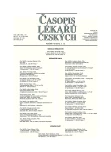-
Medical journals
- Career
Thalidomide epidemics – 50 years after
Authors: Antonín Šípek jr. 1; Antonín Šípek 2,3,4; Eva Maňáková 5
Authors‘ workplace: Ústav biologie a lékařské genetiky 1. lékařská fakulta Univerzity Karlovy a Všeobecná fakultní nemocnice, Praha 1; Ústav obecné biologie a genetiky, 3. lékařská fakulta Univerzity Karlovy, Praha 2; Sanatoriom Pronatal s. r. o., Praha 3; Oddělení lékařské genetiky, Thomayerova nemocnice s poliklinikou, Praha 4; Česká teratologická informační služba, Ústav histologie a embryologie, 3. lékařská fakulta Univerzity Karlovy, Praha 5
Published in: Čas. Lék. čes. 2012; 151: 579-581
Category: Special Articles
Overview
Thalidomide tragedy and the subsequent epidemics of congenital anomalies is one of the most tragic but also enlightening chapters in the history of modern medicine. Many thousands of children were born with various anomalies – especially with limb deformities – because of the mass usage of thalidomide by pregnant women. The numbers of the spontaneous abortions and fetal deaths will remain unknown forever. In year 2012 we have a sad 50th anniversary of final recognition of thalidomide teratogenous potential. The causes of this tragedy and subsequent actions are summarized in our text.
Key words:
thalidomide, teratogenesis, congenital anomalies.
Sources
1. Kalter H. Teratology in the 20th century: environmental causes of congenital malformations in humans and how they were established. Neurotoxicol Teratol 2003; 25(2): 131–282.
2. Gregg NM. Congenital cataract following German measles in the mother. 1941. Aust N Z J Ophthalmol 1991; 19(4): 267–276.
3. Bent N, Tennant A, Neumann V, Chamberlain MA. Living with thalidomide: health status and quality of life at 40 years. Prosthet Orthot Int 2007; 31(2): 147–156.
4. Ito T, Handa H. Deciphering the mystery of thalidomide teratogenicity. Congenit Anom (Kyoto) 2012; 52(1): 1–7.
5. ICBDMS: Congenital malformations worldwide: a report from the International Clearinghouse for Birth Defects Monitoring Systems. Amsterdam: Elsevier 1991; 220 s.
6. Lenz W, Knapp K. Thalidomide embryopathy. Arch Environ Health. 1962; 5 : 100–105.
7. Smithells RW, Newman CG. Recognition of thalidomide defects. J Med Genet 1992; 29(10): 716–723.
8. Kučera J. Populační teratologie. Praha: Avicenum 1989; 325 s.
9. McBride WG. Thalidomide and congenital abnormalities. Lancet 1961; 2 : 358.
10. Lenz W. Thalidomide and congenital abnormalities. Lancet 1962; 1 : 45.
11. Šípek A, Gregor V, Horáček J, Mazánková V, Langhammer P, Šípek A. jr. Historie a současnost registrace vrozených vad v České republice. Čas. Lék. čes. 2009; 148 : 505–509.
12. Chambers C. The role of Teratology Information Services in screening for teratogenic exposures: Challenges and opportunities. Am J Med Gen Part C 2011; 157 : 195–200.
13. Clementi M, DiGianantonio E, Ornoy A. Teratology Information Services in Europe and their contribution to the prevention of congenital anomalies. Community Genet 2002; 5 : 8–12.
14. Stephens TD, Fillmore BJ. Hypothesis: Thalidomide embryopathy – proposed mechanism of action. Teratology 2000; 61 : 189–195.
15. Knobloch J, Rüther U. Shelding light on an old mystery. Cell Cycle 2008; 7 : 1121–1127.
16. Ito T, Ando T, Ogura T, Hotta K, Imamura Y, Yamaguchi Y, Handa H. Identification of a primary target of thalidomide teratogenicity. Science 2010; 327 : 1345–1350.
17. O’Carroll A, O’Reilly F, Whitford DL. What has happened to people affected by thalidomide 50 years on? Ir J Med Sci 2011; 180(2): 475–478.
18. Yang Q, Khoury MJ, James LM, et al. The return of thalidomide: are birth defects surveillance systems ready? Am J Med Genet 1997; 73 : 251–258.
19. Zeldis JB, Williams BA, Thomas SD, Elsayed ME. S.T.E.P.S. A comprehensive program for controlling and monitoring access to thalidomide. Clinical Therapeutics 1999; 21 : 319–330.
20. Celgane Europe Ltd. Thalidomide Celgene – Souhrn údajů o přípravku. 2009. Dostupné na: http://www.ema.europa.eu [cit. 7. 9. 2012].
21. Schuler-Faccini L, Soares RC, de Sousa AC, Maximino C, Luna E, Schwartz IV, Waldman C, Castilla EE. New cases of thalidomide embryopathy in Brazil. Birth Defects Res A Clin Mol Teratol 2007; 79 : 671–672.
22. Vianna FS, Lopez-Camelo JS, Leite JC, Sanseverino MT, Dutra Mda G, Castilla EE, Schüler-Faccini L. Epidemiological surveillance of birth defects compatible with thalidomide embryopathy in Brazil. PLoS One 2011; 6: e21735.
Labels
Addictology Allergology and clinical immunology Angiology Audiology Clinical biochemistry Dermatology & STDs Paediatric gastroenterology Paediatric surgery Paediatric cardiology Paediatric neurology Paediatric ENT Paediatric psychiatry Paediatric rheumatology Diabetology Pharmacy Vascular surgery Pain management Dental Hygienist
Article was published inJournal of Czech Physicians

-
All articles in this issue
- Instruction to the Authors the Journal of Czech Physicians
- Serendipity in medicine
- Role of infection in the pathogenesis of obesity
- Acute multiple organ failure after endoscopic polypectomy
- The use of diagnoses related to tobacco use in the Czech Republic
- Thalidomide epidemics – 50 years after
- Exile of Czechoslovak physicians to Sweden after 1968
- 7th International congress of miniinvasive and robotic surgery, 6th Interactive congress of the wound healing
- Journal of Czech Physicians
- Journal archive
- Current issue
- Online only
- About the journal
Most read in this issue- Thalidomide epidemics – 50 years after
- Acute multiple organ failure after endoscopic polypectomy
- Role of infection in the pathogenesis of obesity
- Exile of Czechoslovak physicians to Sweden after 1968
Login#ADS_BOTTOM_SCRIPTS#Forgotten passwordEnter the email address that you registered with. We will send you instructions on how to set a new password.
- Career

